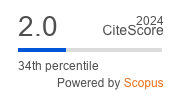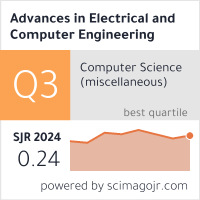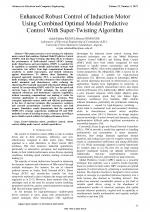| 2/2025 - 5 |
Enhanced Robust Control of Induction Motor Using Combined Optimal Model Predictive Control With Super-Twisting AlgorithmREZGUI, S.-E. |
| Extra paper information in |
| Click to see author's profile in |
| Download PDF |
Author keywords
induction motor, predictive control, robust control, sliding mode control, variable speed drives
References keywords
control(54), induction(27), motor(20), predictive(19), sliding(14), model(13), power(12), mode(11), drives(10), energy(9)
Blue keywords are present in both the references section and the paper title.
About this article
Date of Publication: 2025-06-30
Volume 25, Issue 2, Year 2025, On page(s): 37 - 48
ISSN: 1582-7445, e-ISSN: 1844-7600
Digital Object Identifier: 10.4316/AECE.2025.02005
Web of Science Accession Number: 001555002100005
SCOPUS ID: 105009952899
Abstract
This paper presents a novel strategy for induction motor control that combines Optimal Model Predictive Control (OMPC) with the Super-Twisting Algorithm (STA) to enhance the performance of field-oriented control (IFOC) strategy under disturbances and uncertainties. OMPC is exploited for its capability to optimally handle multivariable systems with constraints, but suffers from high computational demands, sensitivity to model inaccuracies, and limited robustness against disturbances. To address these limitations, the proposed approach integrates STA, a second-order sliding mode technique, which provides robustness when subjected to model mismatch and disturbances, while reducing the chattering effect typically associated with classical sliding mode control. By incorporating OMPC with STA into the speed and currents loops of the IFOC technique, the system gains enhanced robustness and disturbance rejection capabilities, without increasing computational cost making it viable for real-time applications in complex control scenarios. This synergetic approach ensures stable and efficient performance in the face of internal variations (like parameters variation) and external perturbations (variable references and load torque). Simulation results demonstrate that the combined OMPC-STA strategy outperforms traditional PI and SMC methods in terms of tracking accuracy, robustness, providing a more reliable control solution for high-performance drives. |
| References | | | Cited By «-- Click to see who has cited this paper |
| [1] A. G. M. A. Aziz, A. Y. Abdelaziz, Z. M. Ali, A. A. Z. Diab, "A comprehensive examination of vector-controlled induction motor drive techniques," Energies, vol. 16, no. 6, p. 2854, Mar. 2023. [CrossRef] [Web of Science Times Cited 20] [SCOPUS Times Cited 27] [2] O. Otkun, "Newton-Raphson based scalar speed control and optimization of IM," Automatika, vol. 62, no. 1, pp. 55-64, Jan. 2021. [CrossRef] [Web of Science Times Cited 5] [SCOPUS Times Cited 6] [3] I. M. Alsofyani, N. R. N. Idris, K.-B. Lee, "Dynamic hysteresis torque band for improving the performance of lookup-table-based DTC of induction machines," IEEE Trans. Power Electron., vol. 33, no. 9, pp. 7959-7970, Sep. 2018. [CrossRef] [Web of Science Times Cited 50] [SCOPUS Times Cited 67] [4] Y. T. Rao, "Current based restarting method for rotating sensorless induction motor drive," IEEE Trans. Energy Convers., vol. 38, no. 3, pp. 2239-2242, Sep. 2023. [CrossRef] [Web of Science Times Cited 8] [SCOPUS Times Cited 10] [5] A. Nurettin, N. Inanc, "Sensorless vector control for induction motor drive at very low and zero speeds based on an adaptive-gain super-twisting sliding mode observer," IEEE J. Emerg. Sel. Top. Power Electron., vol. 11, no. 4, pp. 4332-4339, Aug. 2023. [CrossRef] [Web of Science Times Cited 27] [SCOPUS Times Cited 37] [6] W. Chen, K. Cheng, K. Chen, "Derivation and verification of a vector controller for induction machines with consideration of stator and rotor core losses," IET Electr. Power Appl., vol. 12, no. 1, pp. 1-11, Jan. 2018. [CrossRef] [Web of Science Times Cited 9] [SCOPUS Times Cited 6] [7] B. Poudel, M. Panwar, R. Hovsapian, "Dynamic response verification of vector controlled induction machines for hydropower emulation," in 2024 IEEE Kansas Power and Energy Conference (KPEC), Manhattan, KS, USA: IEEE, pp. 1-5, Apr. 2024. [CrossRef] [Web of Science Times Cited 2] [SCOPUS Times Cited 3] [8] F. Wang, Z. Zhang, X. Mei, J. Rodriguez, R. Kennel, "Advanced control strategies of induction machine: field oriented control, direct torque control and model predictive control," Energies, vol. 11, no. 1, p. 120, Jan. 2018. [CrossRef] [Web of Science Times Cited 173] [SCOPUS Times Cited 261] [9] K. Ohyama, G. M. Asher, M. Sumner, "Comparative analysis of experimental performance and stability of sensorless induction motor drives," IEEE Trans. Ind. Electron., vol. 53, no. 1, pp. 178-186, Feb. 2006. [CrossRef] [Web of Science Times Cited 110] [SCOPUS Times Cited 133] [10] R. Dey, S. K. Jain, P. K. Padhy, "Robust closed loop reference MRAC with PI compensator," IET Control Theory Appl., vol. 10, no. 18, pp. 2378-2386, Dec. 2016. [CrossRef] [Web of Science Times Cited 20] [SCOPUS Times Cited 24] [11] S. J. Gambhire, D. R. Kishore, P. S. Londhe, S. N. Pawar, "Review of sliding mode based control techniques for control system applications," Int. J. Dyn. Control, vol. 9, no. 1, pp. 363-378, Mar. 2021. [CrossRef] [Web of Science Times Cited 179] [SCOPUS Times Cited 237] [12] N. T. Nguyen, "Model-reference adaptive control," in Advanced Textbooks in Control and Signal Processing, Cham: Springer International Publishing, pp. 83-123, 2018. [CrossRef] [SCOPUS Times Cited 83] [13] J. Yang, Y. Liu, J. Na, G. Gao, "Improving transient performance of modified model reference adaptive control," in Lecture Notes in Electrical Engineering, Singapore: Springer Singapore, pp. 331-343, 2018. [CrossRef] [Web of Science Times Cited 4] [SCOPUS Times Cited 4] [14] A. Levant, "Chattering analysis," IEEE Trans. Autom. Control, vol. 55, no. 6, pp. 1380-1389, Jun. 2010. [CrossRef] [Web of Science Times Cited 362] [SCOPUS Times Cited 435] [15] U. Perez-Ventura, L. Fridman, "Is it reasonable to substitute discontinuous SMC by continuous HOSMC?," arXiv: arXiv:1705.09711. May 26, 2017. [CrossRef] [16] J. Liu, Y. Gao, Y. Yin, J. Wang, W. Luo, G. Sun, "Sliding mode control methodology in the applications of industrial power systems," in Studies in Systems, Decision and Control. Cham: Springer International Publishing, 2020. [CrossRef] [17] N. El Ouanjli, S. Motahhir, A. Derouich, A. El Ghzizal, A. Chebabhi, M. Taoussi, "Improved DTC strategy of doubly fed induction motor using fuzzy logic controller," Energy Rep., vol. 5, pp. 271-279, Nov. 2019. [CrossRef] [Web of Science Times Cited 65] [SCOPUS Times Cited 114] [18] F. Beltran-Carbajal, H. Yanez-Badillo, D. Galvan-Perez, I. Rivas-Cambero, D. Sotelo, C. Sotelo, "B-Spline artificial neural networks in robust induction motor control," IEEE Access, vol. 12, pp. 101679-101700, 2024. [CrossRef] [Web of Science Times Cited 4] [SCOPUS Times Cited 6] [19] H. Hamdi, C. B. Regaya, A. Zaafouri, "A sliding-neural network control of induction-motor-pump supplied by photovoltaic generator," Prot. Control Mod. Power Syst., vol. 5, no. 1, Dec. 2020. [CrossRef] [Web of Science Times Cited 31] [SCOPUS Times Cited 45] [20] M. Schwenzer, M. Ay, T. Bergs, D. Abel, "Review on model predictive control: An engineering perspective," Int. J. Adv. Manuf. Technol., vol. 117, no. 5-6, pp. 1327-1349, Nov. 2021. [CrossRef] [Web of Science Times Cited 565] [SCOPUS Times Cited 744] [21] J. Rodriguez et al., "State of the art of finite control set model predictive control in power electronics," IEEE Trans. Ind. Inform., vol. 9, no. 2, pp. 1003-1016, May 2013. [CrossRef] [Web of Science Times Cited 1427] [SCOPUS Times Cited 1761] [22] J. Rodriguez et al., "Predictive current control of a voltage source inverter," IEEE Trans. Ind. Electron., vol. 54, no. 1, pp. 495-503, Feb. 2007. [CrossRef] [23] M. Nemec, D. Nedeljkovic, V. Ambrozic, "Predictive torque control of induction machines using immediate flux control," IEEE Trans. Ind. Electron., vol. 54, no. 4, pp. 2009-2017, Aug. 2007. [CrossRef] [Web of Science Times Cited 98] [SCOPUS Times Cited 121] [24] Y. Zhang, H. Yang, "Model-predictive flux control of induction motor drives with switching instant optimization," IEEE Trans. Energy Convers., vol. 30, no. 3, pp. 1113-1122, Sep. 2015. [CrossRef] [Web of Science Times Cited 129] [SCOPUS Times Cited 160] [25] J. Rodriguez et al., "Latest advances of model predictive control in electrical drives-Part II: Applications and benchmarking with classical control methods," IEEE Trans. Power Electron., vol. 37, no. 5, pp. 5047-5061, May 2022. [CrossRef] [Web of Science Times Cited 195] [SCOPUS Times Cited 291] [26] Y. Zhang, B. Xia, H. Yang, J. Rodriguez, "Overview of model predictive control for induction motor drives," Chin. J. Electr. Eng., vol. 2, no. 1, pp. 62-76, Jun. 2016. [CrossRef] [SCOPUS Times Cited 87] [27] J. Rodriguez et al., "Latest advances of model predictive control in electrical drives-Part I: Basic concepts and advanced strategies," IEEE Trans. Power Electron., vol. 37, no. 4, pp. 3927-3942, Apr. 2022. [CrossRef] [Web of Science Times Cited 290] [SCOPUS Times Cited 443] [28] H. Xie, W. Tian, X. Gao, F. Wang, J. Rodriguez, R. Kennel, "An ensemble regulation principle for multiobjective finite-control-set model-predictive control of induction machine drives," IEEE Trans. Power Electron., vol. 38, no. 3, pp. 3069-3083, Mar. 2023. [CrossRef] [Web of Science Times Cited 11] [SCOPUS Times Cited 15] [29] Z. Lu, R. Zhang, L. Hu, L. Gan, J. Lin, P. Gong, "Model predictive control of induction motor based on amplitude-phase motion equation," IET Power Electron., vol. 12, no. 9, pp. 2400-2406, Aug. 2019. [CrossRef] [Web of Science Times Cited 17] [SCOPUS Times Cited 23] [30] M. Mamdouh, M. A. Abido, "Efficient predictive torque control for induction motor drive," IEEE Trans. Ind. Electron., vol. 66, no. 9, pp. 6757-6767, Sep. 2019. [CrossRef] [Web of Science Times Cited 56] [SCOPUS Times Cited 72] [31] A. Gurel, E. Zerdali, "Metaheuristic optimization of predictive torque control for induction motor control," Omer Halisdemir Universitesi Muhendis. Bilim. Derg., Aug. 2021. [CrossRef] [32] V. P. Muddineni, A. K. Bonala, T. Penthala, "Dynamic weighting selection for predictive torque and flux control of industrial drives," in Lecture Notes in Electrical Engineering, Singapore: Springer Nature Singapore, pp. 31-44, 2023. [CrossRef] [SCOPUS Times Cited 1] [33] I. Sami, S. Ullah, A. Basit, N. Ullah, J. Ro, "Integral super twisting sliding mode based sensorless predictive torque control of induction motor," IEEE Access, vol. 8, pp. 186740-186755, 2020. [CrossRef] [Web of Science Times Cited 44] [SCOPUS Times Cited 68] [34] K. Zhao, R. Zhou, J. She, C. Zhang, J. He, X. Li, "A model predictive current control based on sliding mode speed controller for PMSM," in 2020 13th International Conference on Human System Interaction (HSI), Tokyo, Japan: IEEE, pp. 229-233, Jun. 2020. [CrossRef] [Web of Science Times Cited 6] [SCOPUS Times Cited 7] [35] H. Xiao, D. Zhao, S. Gao, S. K. Spurgeon, "Sliding mode predictive control: A survey," Annu. Rev. Control, vol. 54, pp. 148-166, 2022. [CrossRef] [Web of Science Times Cited 34] [SCOPUS Times Cited 39] [36] J. A. Rossiter, "A first course in predictive control," Second Edition. CRC Press, pp. 207-252, 2018. [CrossRef] [37] Yen-Shin Lai, Jian-Ho Chen, Chang-Huan Liu, "A universal vector controller for induction motor drives fed by voltage-controlled voltage source inverter," in 2000 Power Engineering Society Summer Meeting (Cat. No.00CH37134), Seattle, WA, USA: IEEE, pp. 2493-2498. 2000. [CrossRef] [38] N. Chatrenour, H. Razmi, H. Doagou-Mojarrad, "Improved double integral sliding mode MPPT controller based parameter estimation for a stand-alone photovoltaic system," Energy Convers. Manag., vol. 139, pp. 97-109, May 2017. [CrossRef] [Web of Science Times Cited 63] [SCOPUS Times Cited 80] [39] M. Maaruf, K. Khan, M. Khalid, "Robust control for optimized islanded and grid-connected operation of solar/wind/battery hybrid energy," Sustainability, vol. 14, no. 9, p. 5673, May 2022. [CrossRef] [Web of Science Times Cited 25] [SCOPUS Times Cited 39] [40] A. Levant, "Sliding order and sliding accuracy in sliding mode control," Int. J. Control, vol. 58, no. 6, pp. 1247-1263, Dec. 1993. [CrossRef] [Web of Science Times Cited 2443] [SCOPUS Times Cited 2969] [41] A. Levant, "Higher-order sliding modes, differentiation and output-feedback control," Int. J. Control, vol. 76, no. 9-10, pp. 924-941, Jan. 2003. [CrossRef] [Web of Science Times Cited 3095] [SCOPUS Times Cited 3733] [42] C. Lascu, F. Blaabjerg, "Super-twisting sliding mode direct torque contol of induction machine drives," in 2014 IEEE Energy Conversion Congress and Exposition (ECCE), Pittsburgh, PA, USA: IEEE, pp. 5116-5122, Sep. 2014. [CrossRef] [SCOPUS Times Cited 47] [43] M. T. Watson, D. T. Gladwin, T. J. Prescott, S. O. Conran, "Dual-mode model predictive control of an omnidirectional wheeled inverted pendulum," IEEEASME Trans. Mechatron., vol. 24, no. 6, pp. 2964-2975, Dec. 2019. [CrossRef] [Web of Science Times Cited 23] [SCOPUS Times Cited 24] [44] M. I. Jahmeerbacus, "Flux vector control of an induction motor drive for energy-efficient operation of a centrifugal pump," in 2015 International Conference on Industrial Engineering and Operations Management (IEOM), Dubai: IEEE, pp. 1-6, Mar. 2015. [CrossRef] [SCOPUS Times Cited 13] [45] A. A. Z. Diab, A.-H. M. El-Sayed, H. H. Abbas, M. A. E. Sattar, "Robust Speed controller design using H_infinity theory for high-performance sensorless induction motor drives," Energies, vol. 12, no. 5, p. 961, Mar. 2019. [CrossRef] [Web of Science Times Cited 20] [SCOPUS Times Cited 24] [46] H. Maghfiroh, A. Maarif, F. Adriyanto, I. Suwarno, W. Caesarendra, "Adaptive linear quadratic gaussian speed control of induction motor using fuzzy logic," J. Eur. Systèmes Autom., vol. 56, no. 4, pp. 703-711, Aug. 2023. [CrossRef] [SCOPUS Times Cited 7] [47] R. Meghwal, V. K. Yadav, M. Vardia, "Robust fuzzy controller design with FPGA implementation for matrix converter based induction motor drive," E-Prime - Adv. Electr. Eng. Electron. Energy, vol. 10, p. 100752, Dec. 2024. [CrossRef] [SCOPUS Times Cited 4] [48] R. Rahmatullah, A. Ak, N. F. O. Serteller, "Design of sliding mode control using SVPWM modulation method for speed control of induction motor," Transp. Res. Procedia, vol. 70, pp. 226-233, 2023. [CrossRef] [SCOPUS Times Cited 10] [49] E. Terfia, S. Mendaci, S. E. Rezgui, H. Gasmi, W. Kantas, "Enhanced control of dual star induction motor via super twisting algorithm: A comparative analysis with classical pi controllers," J. Intell. Syst. Control, vol. 2, no. 4, pp. 220-229, Dec. 2023. [CrossRef] Web of Science® Citations for all references: 9,610 TCR SCOPUS® Citations for all references: 12,280 TCR Web of Science® Average Citations per reference: 192 ACR SCOPUS® Average Citations per reference: 246 ACR TCR = Total Citations for References / ACR = Average Citations per Reference We introduced in 2010 - for the first time in scientific publishing, the term "References Weight", as a quantitative indication of the quality ... Read more Citations for references updated on 2025-11-17 16:39 in 327 seconds. Note1: Web of Science® is a registered trademark of Clarivate Analytics. Note2: SCOPUS® is a registered trademark of Elsevier B.V. Disclaimer: All queries to the respective databases were made by using the DOI record of every reference (where available). Due to technical problems beyond our control, the information is not always accurate. Please use the CrossRef link to visit the respective publisher site. |
Faculty of Electrical Engineering and Computer Science
Stefan cel Mare University of Suceava, Romania
All rights reserved: Advances in Electrical and Computer Engineering is a registered trademark of the Stefan cel Mare University of Suceava. No part of this publication may be reproduced, stored in a retrieval system, photocopied, recorded or archived, without the written permission from the Editor. When authors submit their papers for publication, they agree that the copyright for their article be transferred to the Faculty of Electrical Engineering and Computer Science, Stefan cel Mare University of Suceava, Romania, if and only if the articles are accepted for publication. The copyright covers the exclusive rights to reproduce and distribute the article, including reprints and translations.
Permission for other use: The copyright owner's consent does not extend to copying for general distribution, for promotion, for creating new works, or for resale. Specific written permission must be obtained from the Editor for such copying. Direct linking to files hosted on this website is strictly prohibited.
Disclaimer: Whilst every effort is made by the publishers and editorial board to see that no inaccurate or misleading data, opinions or statements appear in this journal, they wish to make it clear that all information and opinions formulated in the articles, as well as linguistic accuracy, are the sole responsibility of the author.



